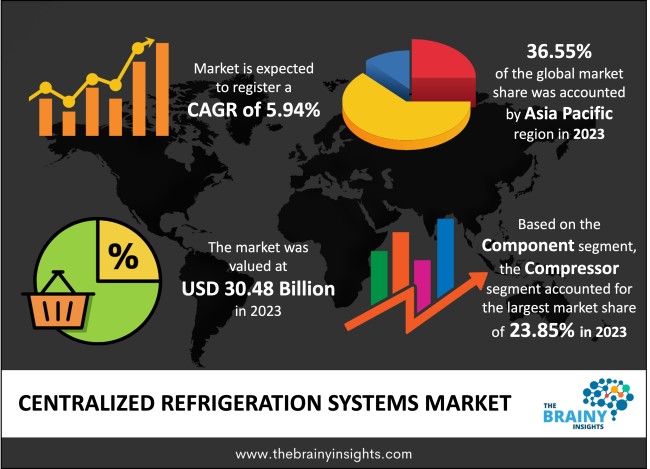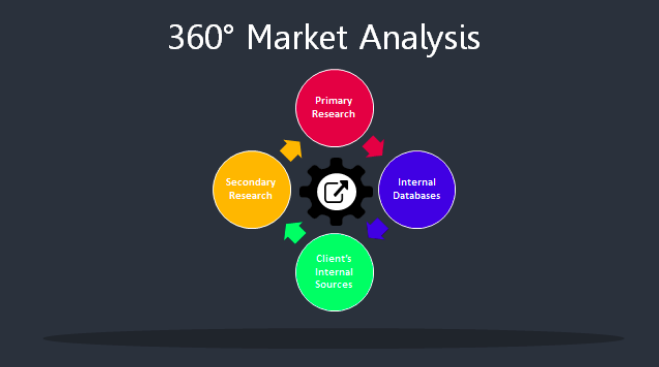- +1-315-215-1633
- sales@thebrainyinsights.com

The global centralized refrigeration systems market was valued at USD 30.48 Billion in 2023, which is anticipated to grow at a CAGR of 5.94% from 2024 to 2033. Since more refrigeration systems are being equipped with energy-saving technologies like screw compressor VFD controls, variable-frequency drives in evaporator fans, floating head pressure controls, and other features, the demand for energy-efficient refrigeration systems has increased. Many industries employ natural refrigerants, such as ammonia, carbon dioxide, water, and others, to counteract environmental effects, including ozone depletion and global warming. The market for eco-friendly refrigerants has increased as a result. Furthermore, using other refrigerants with higher efficiency has been further limited by the availability of natural and eco-friendly refrigerants. This is, therefore, anticipated to have a negative impact on market growth during the forecast period.
Compressors, condensers, and evaporators are some parts of centralized refrigeration systems. Pipes and tubing connect them so that refrigerant can flow through them. Temperature and pressure within the refrigeration system are optimized using refrigeration control systems, which include thermostat, defrost, and head pressure controls. These systems regulate the flow of liquid refrigerant. In addition, doors, pumps, pipes, tubes, OEM equipment, valves, and refrigerant tanks are further parts of centralized refrigeration. A centralized refrigeration system effectively cools one or more big spaces from a single central location. A central cooling unit coupled to a network of pipes or ductwork that distributes cooled air or refrigerant to various locations is the typical configuration of centralized refrigeration systems. Commercial buildings, supermarkets, factories, and other large-scale locations where effective and regular cooling is needed typically use this cooling system. Centralized cooling systems provide better control, higher energy efficiency, and lower maintenance needs than individual cooling systems. Various factors, such as the expansion of the refrigeration sector, an increase in commercial construction projects, and the benefits of centralized refrigeration, are driving the growth of the global market for centralized refrigeration systems. However, severe government rules and high starting and maintenance costs limit business expansion. Furthermore, new opportunities will arise in the upcoming years due to the integration of cutting-edge technology with centralized refrigeration systems. The increasing need for food and drinks due to the growing worldwide population has resulted in higher demands for production, storage, and distribution. Fresh fruit, dairy, meat, and frozen meals are perishable goods whose quality and safety must be maintained through CRS. Specialized refrigeration systems are needed to produce and store beverages, such as juices, soft drinks, and alcoholic beverages. CRS systems are designed to meet the unique requirements of beverage producers. The growth of the food and beverage sector significantly affects demand. This sector is growing because of several factors, including rising consumption, laws governing food safety, cold chain logistics, retail expansion, customization, energy efficiency, environmental concerns, technological advancements, food processing, pharmaceuticals, the beverage industry, and ongoing innovation. Furthermore, new compressor designs like scroll and digital compressors offer higher efficiency and dependability compared to conventional reciprocating compressors. Digital compressors use less energy because they modulate capacity precisely. Technological improvements have made centralized refrigeration systems more dependable, efficient, and sustainable. More technologies will probably surface as energy efficiency regulations and environmental concerns change, propelling the market's expansion. However, installing and buying these systems can incur a heavy upfront expense. This can put a significant financial burden on small and medium-sized businesses and organizations with tight budgets. Elevated operational costs result from inefficient or outdated centralized refrigeration systems using much energy. Businesses' budgets are stretched by these continuous expenses, which makes it difficult for them to stay profitable. It is a challenge for suppliers and manufacturers of these systems to maintain product quality at reasonable prices. Price-conscious consumers who value upfront savings over energy efficiency or cutting-edge features are in the market.

Get an overview of this study by requesting a free sample
Growing need for effective logistics in the cold chain- The growing need for effective cold chain logistics in sectors like food and pharmaceuticals drives the market for centralized refrigeration systems. These systems are essential for keeping perishable commodities at the proper temperature throughout storage and transportation. Environmentally friendly and energy-efficient refrigeration technologies are in demand as environmental implications become more widely recognized. By reducing energy consumption and greenhouse gas emissions, centralized refrigeration systems achieve these goals and adhere to environmental regulations. Centralized refrigeration systems are becoming increasingly popular due to ongoing advancements in compressor technology, refrigerants, and control systems. These developments improve performance and dependability, which attracts the attention of companies looking for cutting-edge solutions. Centralized refrigeration systems are becoming more and more necessary as the retail and food service industries grow. These systems are essential for preserving perishable goods in grocery stores, eateries, and food processing plants. Government rules and incentives encourage businesses to invest in centralized refrigeration systems that promote energy efficiency and environmentally friendly practices. The market is growing due to businesses trying to adhere to environmental regulations. The market for central refrigeration systems is expanding due to the development of cold storage facilities, especially in the food and pharmaceutical industries.
Environmental regulations- Strict environmental laws about the usage of refrigerants severely impact the centralized refrigeration system market. High-GWP refrigerants are being phased out as governments and international organizations seek to reduce greenhouse gas emissions, resulting in the development of alternative, environmentally friendly refrigerants. Established companies in the centralized refrigeration system market may face threats from rapidly advancing technologies and revolutions in the refrigeration sector. Novel advancements, including decentralized cooling strategies, magnetic refrigeration, or substitute cooling techniques, may threaten the established centralized systems and their dominant market share.
The regions analyzed for the market include North America, Europe, South America, Asia Pacific, the Middle East, and Africa. Asia Pacific emerged as the most significant global centralized refrigeration systems market, with a 36.55% market revenue share in 2023. Some of the world's fastest-growing economies, including those of China, India, and Southeast Asian countries, are in the APAC area. The need for cold storage and refrigeration solutions to support various businesses, including food and beverage, medicines, and logistics, is growing as these economies expand. The APAC region's rapid urbanization has resulted in many supermarkets, hypermarkets, convenience stores, and restaurants. These food service and retail businesses rely on CRS for storage and refrigeration, which fuels market expansion.
Asia Pacific Region Centralized Refrigeration Systems Market Share in 2023 - 36.55%
www.thebrainyinsights.com
Check the geographical analysis of this market by requesting a free sample
The component segment is divided into condenser, control, compressor, evaporator, and others. The compressor segment dominated the market, with a market share of around 23.85% in 2023. In centralized refrigeration systems, the compressor is an essential part that compresses the refrigerant gas to increase its temperature and pressure. The market is seeing a rise in the creation of energy-efficient compressors that use cutting-edge technologies, including variable speed drives, better lubrication systems, and optimized designs that lower energy consumption and increase system performance.
The type segment is divided into ammonia, carbon dioxide, f gases, and others. The ammonia segment dominated the market, with a market share of around 26.37% in 2023. Ammonia, which has a high energy efficiency and is environmentally friendly, is the main refrigerant used in ammonia-based centralized refrigeration systems. Ammonia systems are becoming increasingly popular in the market because of their low Global Warming Potential (GWP) and compliance with environmental standards.
| Attribute | Description |
|---|---|
| Market Size | Revenue (USD Billion) |
| Market size value in 2023 | USD 30.48 Billion |
| Market size value in 2033 | USD 54.27 Billion |
| CAGR (2024 to 2033) | 5.94% |
| Historical data | 2020-2022 |
| Base Year | 2023 |
| Forecast | 2024-2033 |
| Region | The regions analyzed for the market are Asia Pacific, Europe, South America, North America, and Middle East & Africa. Furthermore, the regions are further analyzed at the country level. |
| Segments | Component, Type |
As per The Brainy Insights, the size of the centralized refrigeration systems market was valued at USD 30.48 Billion in 2023 & USD 54.27 Billion by 2033.
Global centralized refrigeration systems market is growing at a CAGR of 5.94% during the forecast period 2024-2033.
Asia Pacific region emerged as the largest market for the centralized refrigeration systems.
Growing need for effective logistics in the cold chain is a significant driving factor for the growth of the centralized refrigeration systems market.
Environmental regulation is a significant restraining factor for the growth of the centralized refrigeration systems market.
Key players are Carrier Global Corporation, Gea Group, Lu-Ve S.P.A., Evapco, Inc., Industrial Frigo S.R.L., Johnson Controls, Bitzer Se (Bitzer Kuhlmaschinenbau Gmbh), Daikin Industries Ltd., Emerson Electric Co., Danfoss, among others.
This study forecasts revenue at global, regional, and country levels from 2020 to 2033. The Brainy Insights has segmented the global centralized refrigeration systems market based on below mentioned segments:
Global Centralized Refrigeration Systems by Component:
Global Centralized Refrigeration Systems by Type:
Global Centralized Refrigeration Systems by Region:
Research has its special purpose to undertake marketing efficiently. In this competitive scenario, businesses need information across all industry verticals; the information about customer wants, market demand, competition, industry trends, distribution channels etc. This information needs to be updated regularly because businesses operate in a dynamic environment. Our organization, The Brainy Insights incorporates scientific and systematic research procedures in order to get proper market insights and industry analysis for overall business success. The analysis consists of studying the market from a miniscule level wherein we implement statistical tools which helps us in examining the data with accuracy and precision.
Our research reports feature both; quantitative and qualitative aspects for any market. Qualitative information for any market research process are fundamental because they reveal the customer needs and wants, usage and consumption for any product/service related to a specific industry. This in turn aids the marketers/investors in knowing certain perceptions of the customers. Qualitative research can enlighten about the different product concepts and designs along with unique service offering that in turn, helps define marketing problems and generate opportunities. On the other hand, quantitative research engages with the data collection process through interviews, e-mail interactions, surveys and pilot studies. Quantitative aspects for the market research are useful to validate the hypotheses generated during qualitative research method, explore empirical patterns in the data with the help of statistical tools, and finally make the market estimations.
The Brainy Insights offers comprehensive research and analysis, based on a wide assortment of factual insights gained through interviews with CXOs and global experts and secondary data from reliable sources. Our analysts and industry specialist assume vital roles in building up statistical tools and analysis models, which are used to analyse the data and arrive at accurate insights with exceedingly informative research discoveries. The data provided by our organization have proven precious to a diverse range of companies, facilitating them to address issues such as determining which products/services are the most appealing, whether or not customers use the product in the manner anticipated, the purchasing intentions of the market and many others.
Our research methodology encompasses an idyllic combination of primary and secondary initiatives. Key phases involved in this process are listed below:

The phase involves the gathering and collecting of market data and its related information with the help of different sources & research procedures.

The data procurement stage involves in data gathering and collecting through various data sources.
This stage involves in extensive research. These data sources includes:
Purchased Database: Purchased databases play a crucial role in estimating the market sizes irrespective of the domain. Our purchased database includes:
Primary Research: The Brainy Insights interacts with leading companies and experts of the concerned domain to develop the analyst team’s market understanding and expertise. It improves and substantiates every single data presented in the market reports. Primary research mainly involves in telephonic interviews, E-mail interactions and face-to-face interviews with the raw material providers, manufacturers/producers, distributors, & independent consultants. The interviews that we conduct provides valuable data on market size and industry growth trends prevailing in the market. Our organization also conducts surveys with the various industry experts in order to gain overall insights of the industry/market. For instance, in healthcare industry we conduct surveys with the pharmacists, doctors, surgeons and nurses in order to gain insights and key information of a medical product/device/equipment which the customers are going to usage. Surveys are conducted in the form of questionnaire designed by our own analyst team. Surveys plays an important role in primary research because surveys helps us to identify the key target audiences of the market. Additionally, surveys helps to identify the key target audience engaged with the market. Our survey team conducts the survey by targeting the key audience, thus gaining insights from them. Based on the perspectives of the customers, this information is utilized to formulate market strategies. Moreover, market surveys helps us to understand the current competitive situation of the industry. To be precise, our survey process typically involve with the 360 analysis of the market. This analytical process begins by identifying the prospective customers for a product or service related to the market/industry to obtain data on how a product/service could fit into customers’ lives.

Secondary Research: The secondary data sources includes information published by the on-profit organizations such as World bank, WHO, company fillings, investor presentations, annual reports, national government documents, statistical databases, blogs, articles, white papers and others. From the annual report, we analyse a company’s revenue to understand the key segment and market share of that organization in a particular region. We analyse the company websites and adopt the product mapping technique which is important for deriving the segment revenue. In the product mapping method, we select and categorize the products offered by the companies catering to domain specific market, deduce the product revenue for each of the companies so as to get overall estimation of the market size. We also source data and analyses trends based on information received from supply side and demand side intermediaries in the value chain. The supply side denotes the data gathered from supplier, distributor, wholesaler and the demand side illustrates the data gathered from the end customers for respective market domain.

The supply side for a domain specific market is analysed by:
The demand side for the market is estimated through:
In-house Library: Apart from these third-party sources, we have our in-house library of qualitative and quantitative information. Our in-house database includes market data for various industry and domains. These data are updated on regular basis as per the changing market scenario. Our library includes, historic databases, internal audit reports and archives.
Sometimes there are instances where there is no metadata or raw data available for any domain specific market. For those cases, we use our expertise to forecast and estimate the market size in order to generate comprehensive data sets. Our analyst team adopt a robust research technique in order to produce the estimates:
Data Synthesis: This stage involves the analysis & mapping of all the information obtained from the previous step. It also involves in scrutinizing the data for any discrepancy observed while data gathering related to the market. The data is collected with consideration to the heterogeneity of sources. Robust scientific techniques are in place for synthesizing disparate data sets and provide the essential contextual information that can orient market strategies. The Brainy Insights has extensive experience in data synthesis where the data passes through various stages:


Market Deduction & Formulation: The final stage comprises of assigning data points at appropriate market spaces so as to deduce feasible conclusions. Analyst perspective & subject matter expert based holistic form of market sizing coupled with industry analysis also plays a crucial role in this stage.
This stage involves in finalization of the market size and numbers that we have collected from data integration step. With data interpolation, it is made sure that there is no gap in the market data. Successful trend analysis is done by our analysts using extrapolation techniques, which provide the best possible forecasts for the market.
Data Validation & Market Feedback: Validation is the most important step in the process. Validation & re-validation via an intricately designed process helps us finalize data-points to be used for final calculations.

The Brainy Insights interacts with leading companies and experts of the concerned domain to develop the analyst team’s market understanding and expertise. It improves and substantiates every single data presented in the market reports. The data validation interview and discussion panels are typically composed of the most experienced industry members. The participants include, however, are not limited to:
Moreover, we always validate our data and findings through primary respondents from all the major regions we are working on.
Free Customization
Fortune 500 Clients
Free Yearly Update On Purchase Of Multi/Corporate License
Companies Served Till Date